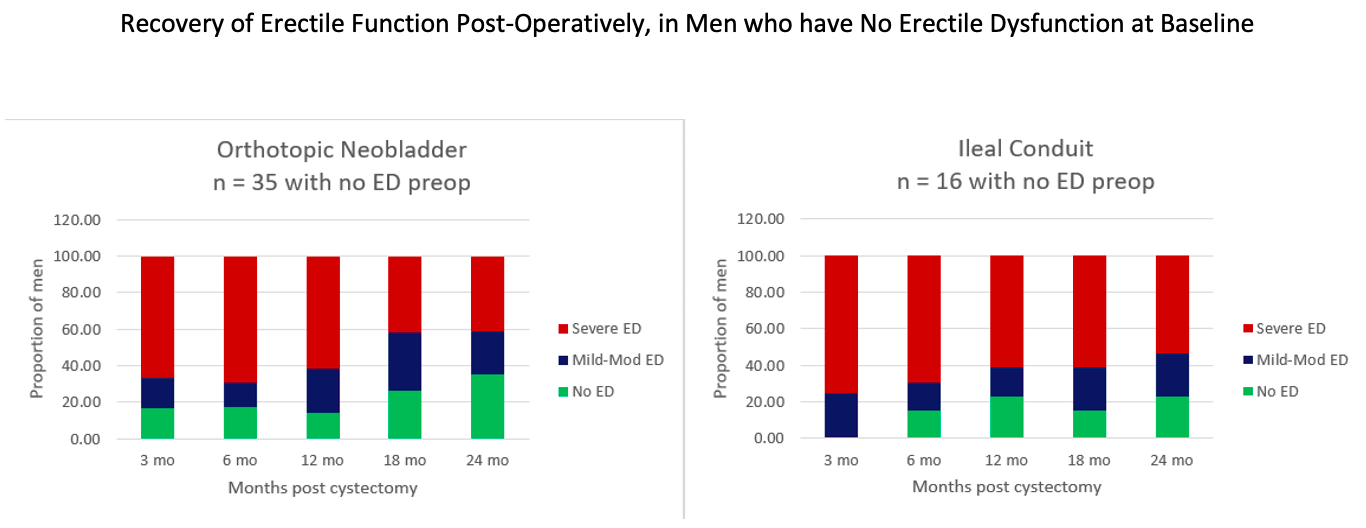Back
Poster, Podium & Video Sessions
Podium
PD10: Bladder Cancer: Invasive II
PD10-04: Characterizing Male Erectile Function After Radical Cystectomy
Friday, May 13, 2022
1:30 PM – 1:40 PM
Location: Room 255
Benjamin Beech*, Matthew Clements, Thomas Atkinson, Yuelin Li, Guido Dalbagni, Andrew Vickers, Harry Herr, S. Machele Donat, Daniel Sjoberg, Amy Tin, John Mulhall, New York, NY, Bruce Rapkin, Bronx, NY, Bernard Bochner, New York, NY

Benjamin Beech, MD, FRCSC
Memorial Sloan Kettering Cancer Center
Podium Presenter(s)
Introduction: Radical cystectomy (RC) is understood to have a large impact on sexual function, but long-term outcomes and the impact of preoperative function have been poorly characterized. Our objective was to examine the natural history of male erectile function (EF) before and following RC.
Methods: Male patients participating in a single-center, prospective, non-randomized study of patient reported quality of life that accrued between 2008-2014 were analyzed. Patients completed the International Index of Erectile Function (IIEF) at their presurgical visit and 3, 6, 12, 18, and 24 months post-RC. Baseline differences between orthotopic neobladder (NB) and ileal conduit (IC) patients were separately analyzed based on significant surgical selection bias. Using established erectile dysfunction (ED) severity definitions for the IIEF, patients were categorized into “severe ED”, “mild-moderate ED”, or “no ED” at baseline and post-RC. We were interested in recovery of EF in patients with no preop ED and examined EF in this cohort over time.
Results: A total of 323 men were eligible, of which 210 completed baseline IIEF surveys. NB was performed in 115 (55%) men and IC in 95 (45%). Any attempt at bilateral or unilateral nerve sparing was performed in 50% of NB and 11% of IC patients. IC patients were older (73 vs 63 years, p<0.001), and had higher rates of severe ED (65% vs 44%, p=0.002) and lower rates of no ED (17% vs 30%, p=0.02) prior to RC. Post-RC, 84% of men reported having severe ED at 12 months and 79% at 24 months. However, among 35 men with no ED preop and NB diversion, 16.7% reported no ED at 3 months. In this group, the largest recovery occurred from 12-24 months, where rates of no ED improved from 14% to 35%. Notably, in these patients, 67% had bilateral nerve sparing and 22% underwent partial nerve sparing. Thus, in men that are potent preop, with nerve sparing, >60% report some EF, while >30% report no ED within two years.
Conclusions: Men who are candidates for NB (younger, less comorbid compared to IC patients) have considerably higher baseline EF. Most recovery appeared to occur after 12 months. In highly selected patients with good baseline EF, EF recovery is possible for the majority following RC with nerve preservation surgery.
Source of Funding: This work was supported by the Sidney Kimmel Center for Prostate and Urological Cancers and the NIH/NCI Cancer Center Support Grant P30 CA008748

Methods: Male patients participating in a single-center, prospective, non-randomized study of patient reported quality of life that accrued between 2008-2014 were analyzed. Patients completed the International Index of Erectile Function (IIEF) at their presurgical visit and 3, 6, 12, 18, and 24 months post-RC. Baseline differences between orthotopic neobladder (NB) and ileal conduit (IC) patients were separately analyzed based on significant surgical selection bias. Using established erectile dysfunction (ED) severity definitions for the IIEF, patients were categorized into “severe ED”, “mild-moderate ED”, or “no ED” at baseline and post-RC. We were interested in recovery of EF in patients with no preop ED and examined EF in this cohort over time.
Results: A total of 323 men were eligible, of which 210 completed baseline IIEF surveys. NB was performed in 115 (55%) men and IC in 95 (45%). Any attempt at bilateral or unilateral nerve sparing was performed in 50% of NB and 11% of IC patients. IC patients were older (73 vs 63 years, p<0.001), and had higher rates of severe ED (65% vs 44%, p=0.002) and lower rates of no ED (17% vs 30%, p=0.02) prior to RC. Post-RC, 84% of men reported having severe ED at 12 months and 79% at 24 months. However, among 35 men with no ED preop and NB diversion, 16.7% reported no ED at 3 months. In this group, the largest recovery occurred from 12-24 months, where rates of no ED improved from 14% to 35%. Notably, in these patients, 67% had bilateral nerve sparing and 22% underwent partial nerve sparing. Thus, in men that are potent preop, with nerve sparing, >60% report some EF, while >30% report no ED within two years.
Conclusions: Men who are candidates for NB (younger, less comorbid compared to IC patients) have considerably higher baseline EF. Most recovery appeared to occur after 12 months. In highly selected patients with good baseline EF, EF recovery is possible for the majority following RC with nerve preservation surgery.
Source of Funding: This work was supported by the Sidney Kimmel Center for Prostate and Urological Cancers and the NIH/NCI Cancer Center Support Grant P30 CA008748


.jpg)
.jpg)